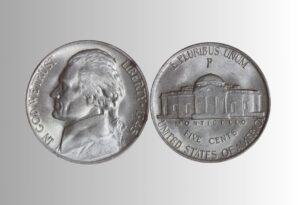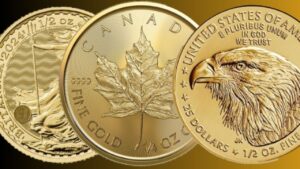
1944 Wheat Penny Value Guide: What Collectors Need to Know
The 1944 Wheat Penny holds a special place in numismatics as a symbol of American history during World War II. The 1944 version marked a return to the traditional copper composition, albeit with a slight twist. These copper coins were made using spent ammunition shell casings. This distinctive origin story not only embodies the resourcefulness of the era but also adds an exciting chapter to the coin’s historical narrative.

Collectors often seek out the 1944 Wheat Penny not only because of its backstory but also due to its value, which can vary greatly. The majority of these pennies are pretty common; however, there are a few rare error coins, such as the 1944 steel penny, which was mistakenly produced when leftover steel blanks from the previous year were used. This rare error coin can be particularly valuable, with some pieces fetching high prices, depending on their condition and rarity.
Key Takeaways
- The 1944 Wheat Penny is a historically significant coin, produced from recycled ammunition shells.
- Values vary for the 1944 Wheat Penny, with some rare error coins commanding high prices.
- Condition, rarity, and historical context are essential factors in determining the coin’s overall value and appeal to collectors.
The Basics of the 1944 Wheat Penny

The 1944 Wheat Penny is a classic American coin, distinguishable by its iconic imagery and historical significance. It was minted during a period of American history where coins were more than just currency; they were a symbol of patriotism and recovery during the post-war era.
Design and Imagery
The Obverse (Heads) side of the 1944 Wheat Penny features the profile of Abraham Lincoln, the 16th President of the United States, indicating the nation’s respect for his leadership. The phrases “In God We Trust” and “Liberty” flank Lincoln’s image, while the year of minting, 1944, appears prominently. This side was designed by Victor David Brenner, whose initials may be found on some versions of the coin.
The Reverse (Tails) side is known for the Wheat Ears design, giving the coin its nickname “Wheat Penny.” It includes the inscriptions “One Cent” and “United States of America,” signifying the coin’s denomination and country of origin.
Metal Composition
The 1944 Wheat Penny is made from a metal composition of 95% copper and the remaining consisting of tin and zinc. During this period, these coins were struck on planchets which embodied a sense of repurposing, as the copper used was sourced from reclaimed ammunition shells—a reflection of the nation’s recuperation after World War II.
- Composition: 95% Copper, 5% Tin and Zinc
Mint Marks and Their Meanings
Mint marks on coins signify their place of origin. There are three main varieties of the 1944 Wheat Penny, each differentiated by a mint mark indicating its production facility:
- No Mint Mark: Coins without a mint mark were produced at the Philadelphia Mint and are the most common.
- “D” Mint Mark: The 1944-D coins were minted in Denver.
- “S” Mint Mark: The 1944-S coins originate from San Francisco.
These mint marks can be found below the date on the obverse side of the penny and provide a clue into their rarity and potential value for collectors.
Mintage and Distribution

The 1944 Wheat Penny signifies a period of transition in the United States, marked by its high production numbers during the postwar era. The US Mint released them into circulation to replace the steel cents from WWII, thus resuming the use of copper in penny production.
Quantity Produced
The US Mint struck a considerable number of 1944 Pennies, amounting to over two billion coins across its three facilities. Specifically, the mintage figures for the 1944 Wheat Penny were as follows:
- Philadelphia Mint (no mint mark): 1,435,400,000
- Denver Mint (D): 430,578,000
- San Francisco Mint (S): 282,760,000
This volume indicates that the 1944 Penny was minted in mass quantities to meet the demand for circulating coinage during a time of economic recovery.
Release into Circulation
Upon production, the 1944 Pennies were immediately released into circulation. They played a vital role in the everyday commerce of post-war America. As with most coins of the era, they were circulated widely and could be found in everyday transactions. The majority of the 1944 Wheat Pennies found today are in circulated condition, with uncirculated examples being less common and typically more desirable for collectors.
The Rarity and Value of 1944 Wheat Pennies

The value of a 1944 Wheat Penny can range dramatically based on its rarity, grade, and specific variety type, with some fetching substantial sums at auctions.
Factors Impacting Value
The worth of a 1944 Wheat Penny is heavily influenced by its condition and grade, ranging from circulated grades to Mint State grades.
Condition is evaluated by grade, which quantifies the state of preservation.
Mint condition coins are at the upper end of the value scale. Another key factor is the presence of a mint mark—a small letter indicating at which U.S. Mint the coin was produced.
Common mint marks for the 1944 Lincoln Cent include “S” for San Francisco and no mark for the Philadelphia Mint. The material of the coin, such as the rare 1944 Steel Wheat Cent, and errors like the D/S error also determine its rarity and enhance value.
Recognizing Valuable Varieties
Certain varieties of the 1944 Lincoln Cent are extremely valuable.
The 1944 Steel Penny is particularly rare due to a transitional error where a few were struck on steel planchets left over from 1943.
The 1944-D/S variety, where the mint mark was over-stamped, represents another valuable error.
Identifying these varieties requires examining the coin for discrepancies in mint marks or the metal’s composition.
Estimated Values and Record Auctions
A standard 1944 Lincoln Cent in extremely fine grade might be worth only a few cents, while one in Mint State can be valued at around 45 dollars.
However, auction records show that exceptional pieces, like a 1944 Lincoln Penny sold for over $373,750, can command staggering prices.
The Red Book and NGC provide further insights on coin values, documenting previous auction records and giving a benchmark for current estimates and past sales.
Please note that the specific links in the paragraphs connect to detailed information on the respective details of the 1944 Wheat Penny.
Grading and Condition Assessment

Grading a 1944 Wheat Penny is instrumental in determining its market value and collectability. Precise grading examines the level of wear and color, categorizing coins from ‘Good’ to ‘MS 66,’ which denotes an uncirculated condition.
Official Grading Standards
The official grading of the 1944 Wheat Penny follows a strict standard set by numismatic professionals.
An Uncirculated coin, designated as MS 66, exhibits no trace of wear with its original luster completely intact.
As grades descend, Extremely Fine coins may show very slight wear, with all major features sharp and clear.
A coin in Fine condition retains moderate to considerable detail, while one graded as Good will display heavy wear with the main design still visible.
The grading criterion also accounts for the penny’s color, which can be Red, Brown, or a mix of both, influencing its desirability amongst collectors.
Self-Grading Tips for Collectors
For collectors looking to assess their own 1944 Wheat Pennies, they should start with examining the coin’s surface under good lighting.
This helps in identifying the level of detail still visible, such as Lincoln’s facial features and the wheat stalks.
An uncirculated coin will have a uniform copper luster, free from blemishes, while circulated grades will show varying degrees of wear.
The penny’s color is crucial as well; a full Red coin is often more valuable than those with a Brown hue.
Collectors can reference grading guidelines and compare their penny to high-quality images or use a grading service for accurate assessment.
Remember, self-grading requires honesty and a critical eye to predict how it might be graded by a professional.
Collecting and the Collector’s Market

Collectors of the 1944 Lincoln Wheat Cent are part of an active market, where rarity and condition dictate value. From starting a collection to acquiring rare coins and understanding market trends, enthusiasts seek to own these historical specimens.
Starting a Wheat Penny Collection
For those interested in starting a Wheat Penny collection, the 1944 Lincoln Wheat Cent serves as a common entry point due to its high mintage. However, it’s key to understand their grading:
- Circulated Coins: Typically worth their face value or slightly more.
- Uncirculated Coins: Higher premiums, with values depending on mint mark and condition.
When speaking to a coin dealer, collectors should inquire about the history and grading of available Wheat Pennies to make informed purchasing decisions.
Strategies for Acquiring Rare Pieces
Collectors seeking to acquire rarer specimens like the 1944-D/S Wheat Cent—where an “S” mint mark was mistakenly stamped and then overwritten by a “D”—should:
- Establish relationships with reputable coin dealers and sellers.
- Attend coin auctions and shows for access to a wider range of options.
- Focus on certified coins which provide assurance of a coin’s authenticity and condition.
Trends in Wheat Penny Collecting
The market for Wheat Pennies can fluctuate based on rarity and overall collector demand. Rare errors such as double stamping or missing letters enhance a coin’s value.
Collectors should monitor auction results and connect with the collecting community to stay informed on current trends and valuable specimens.
Historical Context of the 1944 Wheat Penny

The 1944 Wheat Penny marks a significant return to copper after a brief foray into making steel pennies due to wartime metal shortages during WWII.
This transitional period and the coin’s integral role in the American economy during the war highlight its historical importance.
The Transition from Steel to Copper
In 1943, the United States Mint introduced the steel penny due to a critical need to conserve copper for the war effort, specifically for ammunition and shell casings.
These steel cents were a departure from the traditional copper penny and were coated in zinc to prevent rusting. However, they faced issues such as being mistaken for dimes and difficulties with vending machines, which led to their unpopularity.
By 1944, the mint had an ample supply of copper from recycled shell casings from spent ammunition. With this, the mint resumed the production of copper pennies.
The 1944 Wheat Penny is predominantly composed of this WWII ‘Shell Casing’ copper, with a composition of 95% copper and 5% zinc, marking a swift transition back from the less favored steel composition.
The Role of the Penny During WWII
During WWII, the penny continued to be a vital component of everyday transactions in America despite the materials shift.
The 1944 copper cents were colloquially known as WWII ‘Shell Casing’ Cents, as they were minted from copper resources that were once vital to the war. The reintroduction of these pennies was symbolic, as it represented the country’s gradual shift from a wartime economy back towards normalcy.
Although common due to their high mintage, 1944 Steel Cents are considered to be highly collectible errors nowadays. These were mistakenly struck on steel planchets left over from the previous year.
However, any genuine 1944 Steel Penny is a rarity and holds significant numismatic value due to their unusual production circumstances.
Minting Errors and Anomalies
The 1944 Wheat Penny holds particular interest for collectors due to its variety of minting errors, including the well-known steel composition anomaly of that year. These errors add to the coin’s numismatic value and historical intrigue.
Common and Notable Errors
The 1944 Wheat Penny experienced several minting errors during its production. Mint Marks play a crucial role in identifying and classifying these errors.
The most prevalent minting error for this coin is the D/S Error, where coins have both the Denver (D) and San Francisco (S) mintmarks.
Other Penny Errors from this era include doubled dies and off-center strikes. Such errors make certain 1944 Wheat Pennies highly sought after by collectors.
- Doubled Dies: faint duplicates of design elements.
- Off-Center Strikes: images not properly centered on the coin.
Another distinctive error pertaining to the 1944 Wheat Penny is the “1944-D/S Wheat Cent,” which occurs when the mint mark of San Francisco (S) is stamped over Denver’s (D) on the same coin. It is due to overpunching during the minting process, and it adds to the rarity and value of the coin.
The Phenomenon of the 1944 Steel Penny
In what is known as a Transitional Error, a few 1944 Wheat Pennies were struck on steel planchets left over from the 1943 steel cents.
These coins are often referred to erroneously as 1944 “Silver Penny” due to their distinctive color, but they are actually made of steel. The error occurred when steel planchets from the previous year accidentally remained in the hoppers at minting facilities.
- 1944 Steel Wheat Cent: a rare and significant error.
A simple test to identify a 1944 Steel Wheat Penny is checking if it sticks to a magnet; authentic steel cents are magnetic, differentiating them from their copper counterparts.
These error coins, especially if in good condition, are exceedingly rare and can be of great value to coin collectors.
Identifying Fakes and Counterfeits
Collectors often encounter fakes and counterfeits when searching for valuable coins like the 1944 Lincoln Cents.
Authenticating these coins correctly is crucial because their value can be significantly affected by factors such as scarcity, mint marks, composition, and diameter.
Authentication Methods
Authenticating a 1944 Wheat Penny involves verifying its metal composition and physical characteristics.
The majority of these pennies were made of bronze—95% copper and 5% tin and zinc—and should weigh 3.11 grams with a diameter of 19.05 mm.
A magnet test is a quick check, as genuine bronze pennies will not be attracted to a magnet.
In contrast, the extremely rare 1944 steel penny, which was erroneously produced, will be magnetic.
Professional services can provide authenticity through detailed analysis, including scrutiny under magnification to assess wear patterns and strike details.
Common Signs of Counterfeits
Counterfeit 1944 Wheat Pennies are often detected by examining specific details:
- Weight and Dimensions: Counterfeits may not conform to the official weight of 3.11 grams and a diameter of 19.05 mm.
- Surface Details: Look for inconsistencies in the coin’s detail, like the wheat stocks on the reverse or Lincoln’s portrait on the obverse. These can appear too flat or too sharp for a genuine coin.
- Mint Marks: “D” for Denver and “S” for San Francisco, are sometimes added or altered on counterfeits to mimic more valuable mint varieties. Anomalies in the mint mark’s size, shape, or position can indicate a fake.
It is always advised to consult with NGC’s comprehensive guide on common counterfeits for detailed information or get a professional assessment for precise authentication.
Preservation and Care for Collectors
For collectors, maintaining the condition of a 1944 Wheat Penny, especially if it’s a rare copper penny, is crucial.
Proper storage and handling can safeguard the coin’s value and potentially improve its grade, while cleaning should be approached with caution to prevent damage.
Proper Storage Techniques
Collectors should store 1944 Wheat Pennies in a dry, stable environment to prevent corrosion or tarnishing of the copper.
Climate-controlled settings are ideal to avoid extreme temperatures and humidity, which can cause adverse chemical reactions.
Individual coin holders, such as archival-safe flips or capsules, are recommended for each penny.
These holders should be made of inert materials like Mylar or acetate to ensure no reaction with the copper surface.
For added protection, particularly with high-grade or gold-toned Wheat Pennies, storing in an album or safe deposit box can provide a secure and organized method of preservation.
Cleaning and Conservation
Conservation of a 1944 Wheat Penny should prioritize maintaining its original condition.
Cleaning can drastically reduce a coin’s value, and, therefore, is generally discouraged.
If cleaning is necessary, it should only be conducted by professionals. They employ methods that preserve the integrity and patina of the coin.
For at-home care, gentle dusting with a soft brush is permissible, but contact with abrasive materials or harsh chemicals must be avoided.
Any attempt to clean a coin could easily result in scratches, loss of natural luster, and ultimately a lower grade, which can diminish the penny’s value, especially if the coin is rare or in high-demand by collectors.
Frequently Asked Questions
The value and rarity of a 1944 Wheat Penny can vary greatly depending on several specific factors including condition, mint marks, and potential errors.
What is the estimated value of a 1944 Wheat Penny today?
The value of a 1944 Wheat Penny generally ranges from $0.10 to $45, depending on its condition. Uncirculated coins can fetch much higher prices, into the thousands of dollars.
What characteristics classify a 1944 Wheat Penny as rare?
A 1944 Wheat Penny can be considered rare if it contains errors or is one of the few steel cents released by mistake. The condition of the coin also significantly affects its rarity and value.
Does a genuine 1944 Wheat Penny adhere to a magnet?
No, a genuine 1944 Wheat Penny will not stick to a magnet since they are mainly made from copper, reclaimed from ammunition shells used during World War II.
How can one verify if a 1944 Wheat Penny is made of steel?
One can use a magnet to test the composition; a 1944 Steel Cent will adhere to a magnet due to its steel content, unlike the common copper variant.
Are there any notable errors to look for in a 1944 Wheat Penny?
Collectors should look for pennies with double stamping, missing letters, and the rare transition error known as the 1944 Steel Penny.
What factors contribute to the value of a 1944 Wheat Penny with no mint mark?
The value of a no-mint-mark 1944 Wheat Penny can be influenced by its condition and grading. Uncirculated coins and those with errors or unique characteristics can command higher prices.


